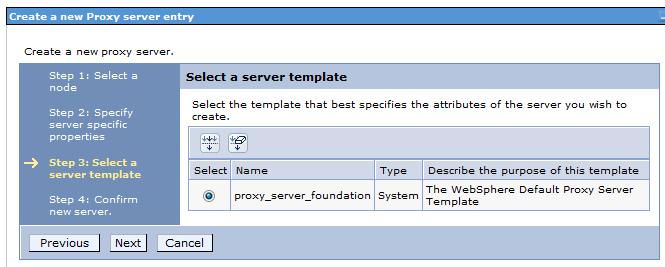Create a proxy server
Proxy servers dynamically route requests to on-demand configuration (ODC) enabled appservers.
When you install WAS ND, two profiles are created:
- stand-alone application server profile (server1)
- deployment manager profile (dmgr)
When creating a proxy server, do not choose the deployment manager profile. Only the appserver profile can be used as the target node.
- Create a proxy server...
Servers | Server Types | WebSphere proxy servers | New

- Select the node on which you want the proxy server to reside.
- Enter a name for the new proxy server and click Next .
- The supported protocols HTTP and SIP are selected for you.

Select HTTP if the proxy server will route requests to and from a Web container. Select SIP if the proxy server will route requests to and from a SIP container.
Determine whether or not to generate unique HTTP ports by selecting or clearing...
If creating multiple proxy servers on the same node for vertical scaling, select generate unique ports to avoid port conflicts. A load balancer can load balance requests to the proxy servers within the same node, assuming that each proxy server is listening on a unique HTTP port. For the proxy server to accept requests for a specific virtual host, it is necessary to add the unique HTTP ports that are generated to the host alias of the virtual host. It might also be necessary to modify the port values that the wizard generates, if these ports conflict with other local servers on the same node.
- Select a proxy server template on which to base the proxy server. Click Next.

You can select a default template, or we can choose to map to an existing proxy server.
Mapping to a pre-existing proxy server is a time-saving technique. We can build one proxy server and apply all of the specific configurations your environment needs, and then use that proxy server as a template.
- Review the summary panel and click Finish .
Results
You now have a functional proxy server that automatically routes HTTP requests to the cell that the proxy server belongs to or SIP requests to and from a SIP container. To enable routing to another cell, configure the cell to communicate with other cells.
If the proxy server fails to start when attempting to start it as a non-privileged user on UNIX-based operating systems, change the ports of the transport chains...
- PROXY_HTTP_ADDRESS
- PROXY_HTTPS_ADDRESS
...to values greater than 1024.
When using the proxy server, one should use the default port. If any other port is used, any https URL redirection might go to the wrong port. This is because the virtual host named default_host might also be using this new port. The https redirection is based on the first https port that it finds in the default_host.
As the number of SIP containers grow in a deployment, the larger the heap settings need to be on the SIP proxy server. For example, a deployment of 20 containers requires a minimum heap size of 60 MB, so a -Xmo60m parameter should be added to the Generic JVM arguments field on the Java virtual machine panel of the admin console. However, a deployment of 70 containers requires a larger value such as 200 MB (-Xmo200m).
Proxy server collection
Proxy server configuration
Proxy server settings
Generic server clusters collection
Generic server clusters configuration
Generic server cluster ports collection
Generic server cluster members
URI groups
URI group configuration
Routing rules
Routing rules configuration
Rewriting rules collection
Rewriting rules configuration
HTTP proxy inbound channel settings
Starting a proxy server
Stopping a proxy server
HTTP proxy server custom properties
SIP proxy server custom properties
SIP container custom properties
Related tasks
Create a server using scripting
Related
Java virtual machine settings